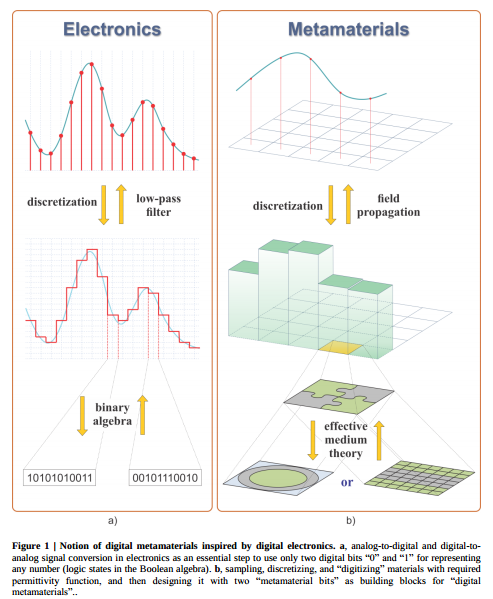A proposed method for digital metamaterials is a simplified way of building metamaterials, yet still allows for complex and diverse properties to be achieved.
Arxiv – Digital Metamaterials (31 pages)
Nature Materials – Digital metamaterials
Balancing complexity and simplicity has played an important role in the development of many fields in science and engineering. One of the well-known and powerful examples of such balance can be found in Boolean algebra and its impact on the birth of digital electronics and the digital information age. The simplicity of using only two numbers, ‘0’ and ‘1’, in a binary system for describing an arbitrary quantity made the fields of digital electronics and digital signal processing powerful and ubiquitous. Here, inspired by the binary concept, we propose to develop the notion of digital metamaterials. Specifically, we investigate how one can synthesize an electromagnetic metamaterial with a desired permittivity, using as building blocks only two elemental materials, which we call ‘metamaterial bits’, with two distinct permittivity functions. We demonstrate, analytically and numerically, how proper spatial mixtures of such metamaterial bits lead to elemental ‘metamaterial bytes’ with effective material parameters that are different from the parameters of the metamaterial bits. We then apply this methodology to several design examples of optical elements, such as digital convex lenses, flat graded-index digital lenses, digital constructs for epsilon-near-zero (ENZ) supercoupling and digital hyperlenses, thus highlighting the power and simplicity of the methodology.
Abstract
Balancing the complexity and the simplicity has played an important role in the development of many fields in science and engineering. As Albert Einstein was once quoted to say: “Everything must be made as simple as possible, but not one bit simpler”. The simplicity of an idea brings versatility of that idea into a broader domain, while its complexity describes the foundation upon which the idea stands. One of the well-known and powerful examples of such balance is in the Boolean algebra and its impact on the birth of digital electronics and digital information age. The simplicity of using only two numbers of “0” and “1” in describing an arbitrary quantity made the fields of digital electronics and digital signal processing powerful and ubiquitous. Here, inspired by the simplicity of digital electrical systems we propose to apply an analogous idea to the field of metamaterials, namely, to develop the notion of digital metamaterials. Specifically, we investigate how one can synthesize an electromagnetic metamaterial with desired materials parameters, e.g., with a desired permittivity, using only two elemental materials, which we call “metamaterial bits” with two distinct permittivity functions, as building blocks. We demonstrate, analytically and numerically, how proper spatial mixtures of such metamaterial bits leads to “metamaterial bytes” with material parameters different from the parameters of metamaterial bits. We also explore the role of relative spatial orders of such digital materials bits in constructing different parameters for the digital material bytes. We then apply this methodology to several design examples such as flat graded-index digital lens, cylindrical scatterers, digital constructs for epsilon-near-zero (ENZ) supercoupling, and digital hyperlens, highlighting the power and simplicity of this methodology and algorithm.
The authors showed in simulations that nano-patterned glass/silver structures can then bend light, which is also the principle behind invisibility cloaking. Fabricating the proposed structures would be challenging but not impossible. It would require structuring glass and metal with a precision of a few atoms in thickness only – but thinking of metamaterials as binary structures may help devise new nano-patterning lithography (printing) techniques that take advantage of this,” he said.
16 pages of supplemental information
If you liked this article, please give it a quick review on ycombinator or StumbleUpon. Thanks

Brian Wang is a Futurist Thought Leader and a popular Science blogger with 1 million readers per month. His blog Nextbigfuture.com is ranked #1 Science News Blog. It covers many disruptive technology and trends including Space, Robotics, Artificial Intelligence, Medicine, Anti-aging Biotechnology, and Nanotechnology.
Known for identifying cutting edge technologies, he is currently a Co-Founder of a startup and fundraiser for high potential early-stage companies. He is the Head of Research for Allocations for deep technology investments and an Angel Investor at Space Angels.
A frequent speaker at corporations, he has been a TEDx speaker, a Singularity University speaker and guest at numerous interviews for radio and podcasts. He is open to public speaking and advising engagements.


